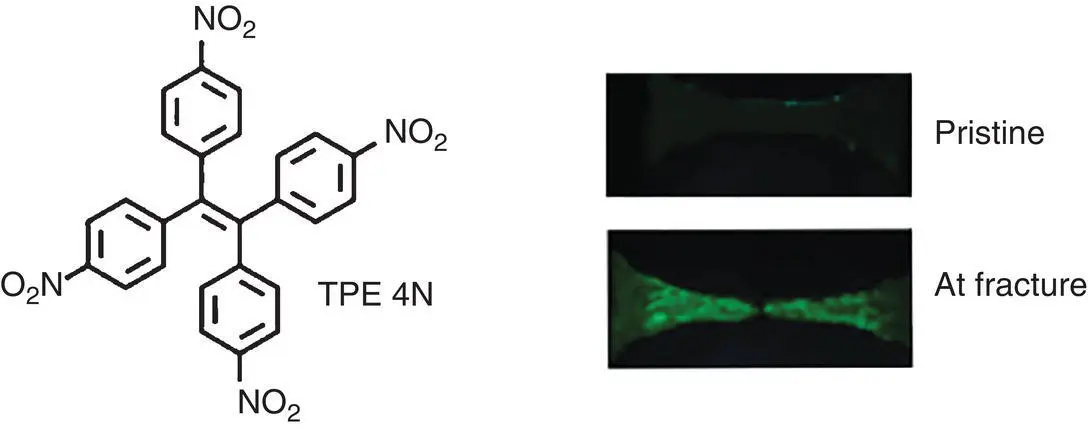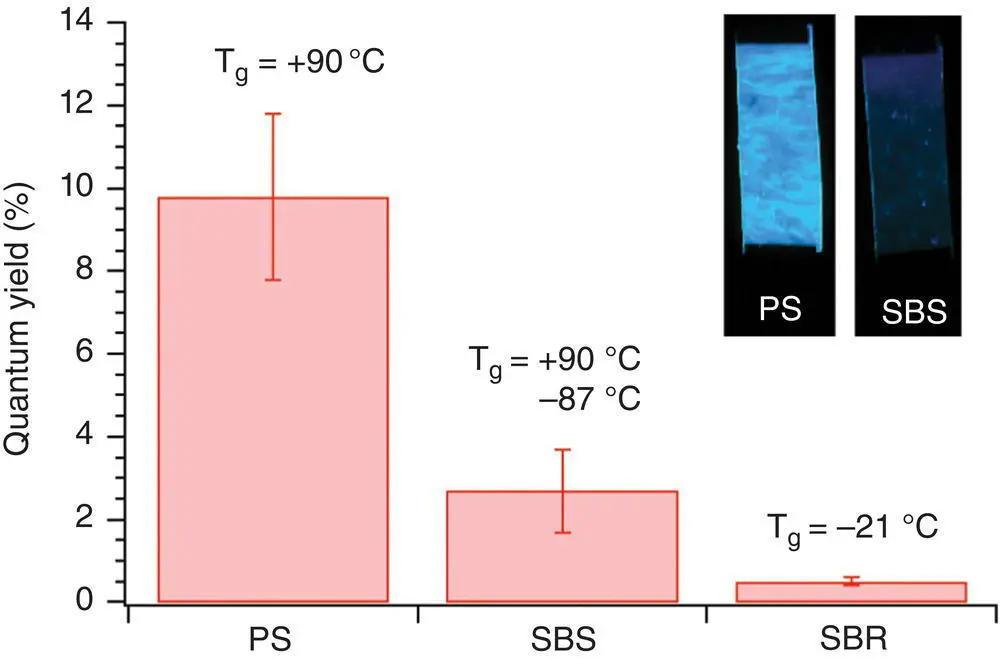Very recently, Tang and his group have proposed the 1,1,2,2‐tetrakis(4‐nitrophenyl)ethene (TPE‐4N; Figure 3.6) as a versatile AIEgen with a very sensitive emission to mechanical stress [64]. In this case, the reported ON–OFF fluorescence behavior was addressed to the intersystem crossing (ISC) process from the excited singlet state to the highly sensitive triplet state that is characterized by a nonemissive character. Experimental investigations reported that the Ph‐NO 2moieties of TPE‐4N in the crystalline phase activate the nonradiative ISC pathway and hence the fluorescence quenching. Conversely, in the amorphous state, the TPE‐4N luminogen recovered its emission with a bright green fluorescence at 520 nm, thus suggesting that the ISC relaxation process is hindered/caused by AIE morphology modification.

Figure 3.6 Chemical structure of TPE‐4N and fluorescence intensity changes of the AIEgen‐coated steel specimen before and after drawing at fracture under the illumination with a long‐range UV lamp.
Profiting from these chromogenic characteristics and the capability of TPE‐4N to form homogeneous films over different materials, the authors proposed the use of this AIEgen as the mechanochromic coating for the detection of stress–strain solicitations of metal surfaces [65]. Notwithstanding the use of TPE‐4N without the presence of a supporting polymer matrix, the coating procedure was identical to those proprietary of commodity plastics and therefore possibly extended to AIE‐doped plastic films. A uniform 1‐μm thick TPE‐4N film was realized over a steel specimen by dip‐coating from a chloroform solution. After drying, the TPE‐4N film displayed the typical strong green fluorescence at 520 nm, owing to the amorphous character of the coated AIEgen. The emission was then totally quenched upon annealing the specimen for 20 minutes at 150 °C due to the promotion of the nonradiative ISC process that was activated by the fluorophore crystallization. The annealed specimen was then utilized for the mechanochromic tests by means of an in situ testing machine. Notably, the fluorescence variation was detected with a charge‐coupled device (CCD) camera under the irradiation with a coaxial UV light. When a uniaxial force was applied, green fluorescence emerged again from the specimen and progressively increased as a function of the external strain ( Figure 3.6). External strain cracks and transforms the nonemissive crystalline TPE‐4N into amorphous TPE‐4N, which shows a green emission.
Owing to the OFF–ON mechanism provided by the TPE‐4N probe, the mechanochromic response was detected even at a very moderate strain of 0.13% and with a progressive enhancement up to deformations of 20%. It was reported that the green emission intensity at drawings of 65% resulted seven times higher than that of the pristine undeformed metal.
3.3.2 Thermochromic AIE‐doped Polymer Films
Thermochromic polymer films have been deeply investigated in the recent literature starting from thermoplastic polymer matrices containing small amounts (<5 wt.%) of physically dispersed dyes or fluorophores able to change their optical features after a temperature change above a certain threshold. The working mechanism at the base of such a system mainly consists of aggregation/deaggregation processes among the chromophoric moieties of the dispersed optical probes [13, 52]. As far as the fluorogenic response is concerned, most of the fluorophore selected experienced thermal stress by decreasing or increasing their emission intensity, thus yielding in an ACQ or aggregation‐induced enhanced emission (AIEE) phenomena [66]. Polymer matrices were reported to behave not only as a mere support for the optical probes but their thermal features in terms of melting (or crystallization) temperature and/or glass‐transition temperature can trigger optical changes in the embedded fluorophore. Therefore, thermochromic polymer films were prepared not only to develop optical sensors but also to provide useful information about the structural changes occurring in the supporting polymer matrix by changing the external temperature.
In connection with these findings, AIE‐doped polymer films have been effectively prepared to determine the glass‐transition temperature ( T g) of different polymers and also for possible temperature sensors in correspondence with the viscosity changes occurring near T g[67]. Below their T g, thermoplastic polymers become strikingly viscous when their translational and rotational motion are restricted. This phenomenon also causes the sudden arrest of any possible rotation of phenyl rings or analogous moieties in a typical AIEgen physically dispersed or covalently linked to the polymer matrix. Therefore, by lowering the temperature below the T g, the AIE‐doped polymer film experiences a striking increase of its emission in a typical reversible OFF–ON feature. In a similar manner, Kokado et al. observed the temperature‐dependent fluorescence change in their covalently linked TPE–PDMS polymer, which was mentioned earlier for the mechanochromic behavior [57]. The T gof the polymer was observed at around −125 °C, and thanks to the presence of the embedded TPE derivative, the fluorescence intensity of the film increased to about eight‐fold at −196 °C. It was worth noticing that the absolute fluorescence quantum yield ( Φ F) increased from 7.8 at room temperature to 59%. The ability of the AIEgen fluorophores to detect temperature changes was effectively exploited by Iasilli et al. [56] who incorporated the TPE molecule into different styrene‐based polymers with the aim to determine their T gvia fluorescence, i.e. the PS, the SBS triblock copolymer, and the styrene–butadiene rubber (SBR, a random copolymer) ( Figure 3.7). Namely, it is well known that the commercially available amorphous PS shows a T gof around 90 °C, whereas SBR utilized in their work displayed a T gat −21 °C. Conversely, SBS (one of the most common thermoplastic elastomers) has two different T gs, one at 70 °C and the other at −87 °C corresponding to the incompatible but covalently linked blocks of styrene and butadiene, respectively. As a consequence, only PS is totally in a glassy state, whereas SBS only partially (only the PS blocks), and SBR is amorphous but not glassy at room temperature. These features were effectively reflected on the emission properties of the derived films containing the 0.1 wt.% of TPE. Among the above three films, the TPE‐doped PS actually showed the highest Φ Fof around 10%, which was lowered to about 2.5% for the doped SBS matrix. In agreement, the SBR films, in which the TPE molecules maintain their phenyl rotations active, are practically nonemissive since the de‐excitation process occurred via nonradiative pathways.

Figure 3.7 Fluorescence Φ Fof PS, SBS, and SBR films doped with 0.1 wt.% of TPE. The inset shows the TPE‐doped PS and SBS films under the excitation of a long‐range UV lamp at 366 nm.
The higher emission of the doped PS film with respect to the corresponding SBS matrix can be easily visualized by exposing the materials to the excitation of a long‐range UV lamp at 366 nm ( Figure 3.7, inset). Analogously, Tang et al. proposed a similar investigation [68], also taking advantages of more sensitive AIEgens with TICT features [69], and achieved a reliable, simple, and fast method for high‐contrast visualization and differentiation of micrometer‐sized phase separation in polymer structures and blends [70]. This method was based on the RIR and on the TICT of several AIEgens, whose fluorescence features (i.e. emission intensity and wavelength) changed in different polymer phases with different rigidities and polarities. Therefore, each polymer phase can be easily labeled and promptly identified thanks to the different fluorescence intensities and wavelengths with high contrast and low background noise.
Читать дальше














